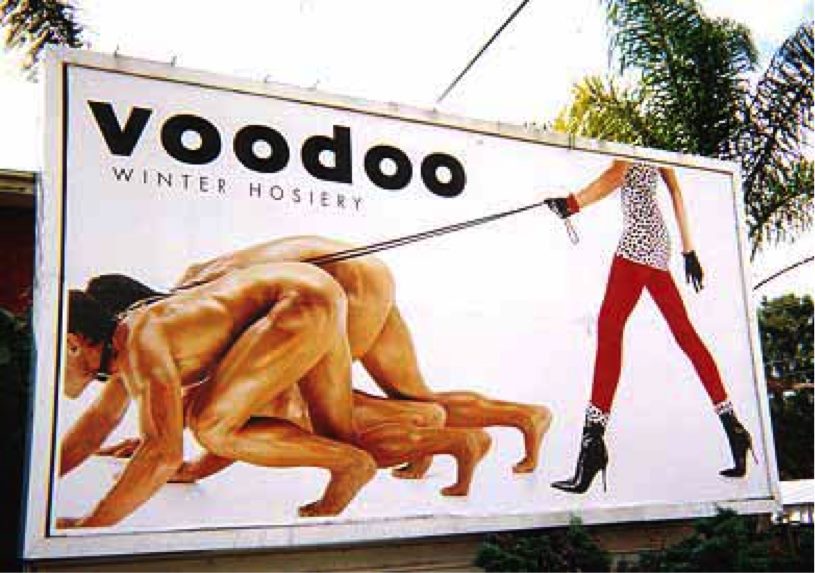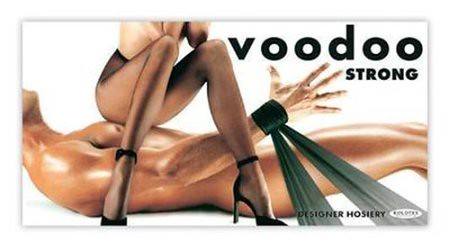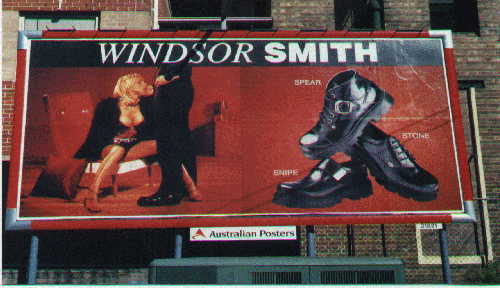Misandric Advertisements
Voodoo
Starting in 2002 (and as of late 2015), Australian based company, Voodoo released an ad marketing campaign featuring men being objectified, and to some extent, being abused. The company is known to feature women wearing their products and dressing in provocative ways, strongly hinting at nudity without actually showing it. This series of advertising differed from their normal type of advertising, showing women having power and control over men to the point of humiliation and degradation.
Voodoo's "men-on-leash" ad generated about 60 complaints to the Advertising Standards Bureau. All were dismissed. The ABS apparently appreciated the humour, reasoning: "This ad clearly intends to depict a tongue-in-cheek view of the well accepted right of a woman to be in control of her choices and her 'accessories'."[1]
Complaints
Various complaints have been made against these misandric advertisements.[2]
“I found the image of a woman walking along with two naked men on dog leashes on their hands and knees very offensive …sexist and derogatory …”
“It depicts men as animals and honestly puts the fight for gender equality back fifty years.”
“This ad is suggestive that men are dogs, are not worthy of wearing clothing and need to be tied to a woman who has the power. It also suggests that a woman can have more than one man. Both of these points contravene the social morays that are part of today’s society and involves discrimination of men as a lesser sex rather than as an equal.”
“This is a moral issue that degrades human value and worth, it brings humans down to the level of animals. For some of the elderly it may bring back memories of war and mistreatment as prisoners of war/slavery. This may also encourage the imagination of some in this direction/treatment of others.”
“If the advertisement was reversed and a male was ‘walking’ two females with a leash, I doubt that the advertisement would even be considered acceptable.”
“I strongly object to this ad’s being placed in the public view where my children were forced to view it today…It is clearly degrading to men to be depicted as some kind of sex slave.”
“Whether some may consider this demeaning to men or women is irrelevant I personally as an adult woman amjme with it … But I do know it has an impact on children. They are the issue.”
“Why do we seem to have one set of standards for women’s representation and another for men?”
“I genuinely feel distressed by seeing this…Such images one might expect in pornographic literature but should not be in the general viewing space.”
“I am greatly concerned of the possible impact this sign could have on impressionable persons. In my view, the sign is suggestive of a gross violation of dignity and of human rights and should not be seen in my country, Australia.”
“This kind of ultra feminism sends the totally wrong message to families where kids and young women think this is acceptable to treat men as ‘pets’ … it’s emasculating and derogatory and heel grinding.”
“I have two daughters aged 4 and 7 and I must ask them to close their eyes every time we pass it. I believe we should have the right to preserve the innocence of our children and not have this type of thing forced upon us.”
Advertiser Response
The Advertising Standards Board (‘the Board’) considered whether this advertisement breaches Section 2 of the Advertiser Code of Ethics (‘the Code’).
The Board considered that while some people clearly had different perceptions of the advertisement, it represented a satirical comment on a patriarchal world. It determined that, as such, the content of the advertisement did not contravene the Code in relation to either the portrayal of people or the portrayal of sex, sexuality and/or nudity. With the Board finding that the advertisement did not breach the Code on any other grounds, the complaint was dismissed.
References
Windsor Smith
Displaying this here to show a contrast of what was deemed misogynistic.
In 2005, an ad depicting a woman wearing very little next to a man fully clothed was believed to be depicting oral sex. The Advertising Standards Board (“Board”) considered whether this advertisement breaches Section 2 of the Advertiser Code of Ethics (the “Code”).
The Board noted the complainants’ concerns that the advertisement objectifies women and is sexist in its depiction of them dressed in clothing similar to swimwear while the men are fully clothed, and features inappropriate close ups of a female backside which is not suitable for viewing by children. The Board noted the complainants’ concerns that it is sexist to show women half-dressed whilst the men are fully clothed. The Board noted that the advertisement is for shoes and considered that the depiction of women wearing swimwear or dancewear is not relevant to the advertised product. The Board noted however that the Code does not require that images of women are only used in relation to relevant products.
The Board determined that the advertisement didn't breach any section of the Code, and the complaints were dismissed. However, the billboard company stepped in and took the advert down. Note that while the Voodoo Hosiery was not taken down by the Board just like Windsor Smith, the billboard company did leave the Voodoo campaign up.
Complaints
- I am offended by the Men being fully clothed, whilst women are only wearing small underwear. I am particularly offended by two separate shots of a woman bent over, in her underwear, and the camera zooming in on her bum and vagina. I am offended by the sexism in this advert, and am also upset that it was played in the morning in front of my young girl. An utterly horrible display of disrespect to women, and a terrible example to my daughter.
- Women portrayed as sexual objects. Element of acceptable subjugation of women. Clad in underwear while men are fully dressed. Women objectified - faces often obscured. Poor rolemodel. Women portrayed as being useful to men but not empowered.
- I believe that the advertisement is inappropriate with half naked women bending over and prancing around. Its very offencive and its not appropriate. I dont want my teenage daughter seeing that and thinking its ok to act and dress like that.
Advertiser Response
It should be noted that the advertiser for this campaign was led by a mostly female team.
Complaint #1 Response: - The females are in swimwear, not underwear as well as clothing - There is no scene where the camera zooms in on her vagina or her bottom and she is not in underwear, she is in swimwear - There is no intended sexism in this advert nor is there an intention to display disrespect to women - The girls are dancers and just like ballerinas wear leotards these girls have specific dance costumes
Complaint #2 Response: - The female models were wearing swimwear not underwear - Shots are choreographed as a dance sequence as apposed to close up shots on bottoms to which there are none - any close up shots are to represent the mood and/or highlight the product
Complaint #3 Response: - The mens shots are full looks of styles suggested to wear with the product - No element of this is sexist, the group are having fun together



